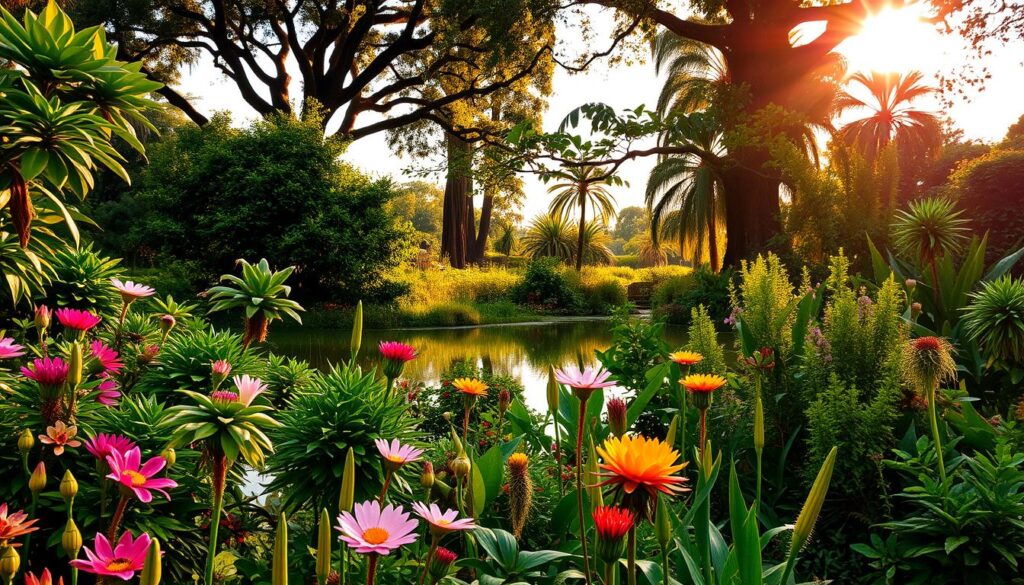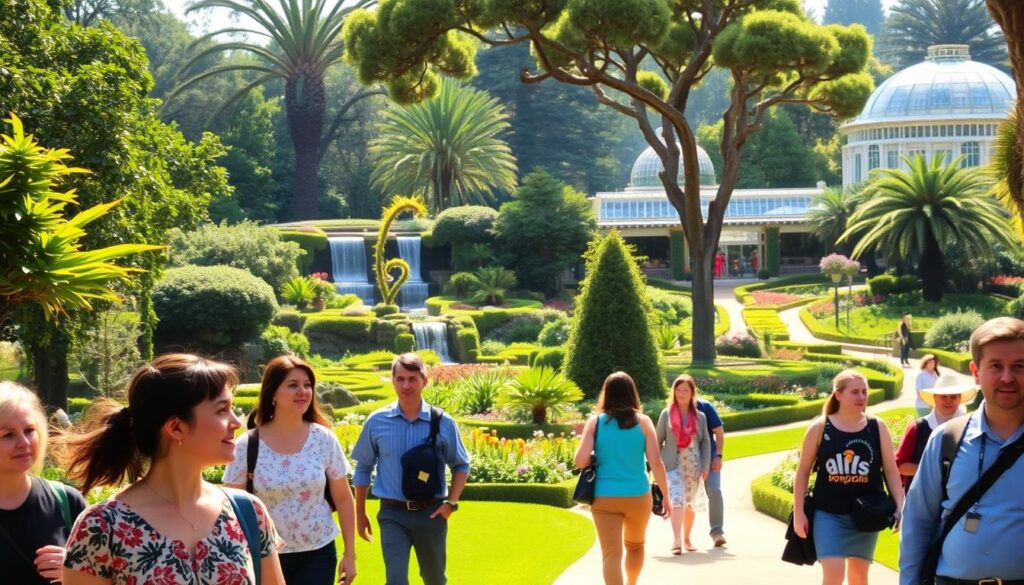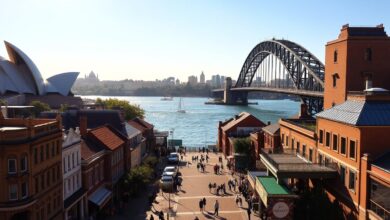The Royal Botanic Garden in Melbourne, Australia, is a haven of natural beauty. It attracts visitors from all over the world. It’s known for its diverse flora and fauna.
Located in the heart of the city, this stunning garden is a must-see for nature lovers. It offers a peaceful escape from the city’s noise.
The garden has a rich history and beautiful landscapes. It’s a true gem. It showcases the beauty of Australian flora with its array of plant species.
Key Takeaways
- Discover the diverse flora and fauna within the Royal Botanic Garden.
- Explore the garden’s rich history and its significance.
- Experience the serene landscapes and natural beauty.
- Learn about the various plant species on display.
- Understand why the Royal Botanic Garden is a must-visit destination.
A Brief Overview of the Royal Botanic Garden
The Royal Botanic Garden is a true marvel of nature. It boasts stunning landscapes and a vast array of flora. This esteemed institution has been a cornerstone of botanical research and conservation for over a century.
Established in 1845, the garden has a rich history. It is deeply intertwined with the development of botanical science. Its significance extends beyond its beautiful landscapes. It serves as a hub for education, research, and conservation.
History and Significance
The Royal Botanic Garden was founded to cultivate and study plant species from around the world. Over the years, it has grown to become one of the most significant botanical gardens globally. It houses over 8,500 different species of plants.
The garden’s historical significance is not just in its age. It has also made significant contributions to botanical research and conservation efforts. It has played a key role in the discovery and classification of numerous plant species.
Location and Size
The Royal Botanic Garden spans 38 hectares in the heart of the city. Its size allows for a diverse range of flora to be cultivated. From tropical plants to native Australian species, it has it all.
| Attribute | Detail |
|---|---|
| Location | City Centre |
| Size | 38 hectares |
| Number of Species | Over 8,500 |
Visitor Information
Visitors can enjoy guided tours and walk through the beautiful landscapes. They can explore the various plant species on display. The garden is open daily from 7:30 am to sunset. Admission is free, but some special exhibitions and events may require a fee.
- Opening Hours: 7:30 am – Sunset
- Admission: Free (some exhibitions may require a fee)
- Guided Tours: Available daily
The Royal Botanic Garden is a must-visit for botany enthusiasts and nature lovers. It offers a serene escape from the hustle and bustle of city life.
Unique Flora and Fauna
The Royal Botanic Garden is famous for its flora and fauna. It has a huge variety of plants and animals. It’s a paradise for those who love nature.
Indigenous Plant Species
The garden has many indigenous plant species. You can see eucalyptus, banksias, and wattles. These plants are not just pretty; they help the local environment too.
A horticulture expert says, “Saving indigenous plants is key for biodiversity and balance.”
“Native plants are the backbone of our ecosystem, providing sustenance and shelter for native wildlife.”
Rare and Endangered Species
In the garden, you can see rare and endangered species. Look out for the Wollemi pine and the Tasmanian blue gum. The garden works hard to protect these plants and their homes.
- The Wollemi pine, once thought to be extinct, is now protected and cultivated within the garden.
- The Tasmanian blue gum, known for its striking bark, is another species that is conserved through the garden’s efforts.
Wildlife Habitats
The garden has different habitats for wildlife. You can see birds, insects, and small mammals. The garden makes sure these animals have a safe place to live.
The mix of native plants and habitats makes the Royal Botanic Garden special. By following Botanic Garden Tips and exploring the Secret Garden Beauty, visitors can enjoy the garden’s wonders even more.
Design and Layout of the Garden
The Royal Botanic Garden Melbourne is a masterpiece of design. It’s not just a place with plants; it’s a journey through nature’s beauty. The garden’s layout is a blend of art and science, making it a stunning botanic garden.
Landscaping Techniques
The garden’s design uses both old and new landscaping methods. This mix creates a unique and beautiful space. It features native Australian plants and exotic species, making it diverse and visually stunning.
The gardeners use many techniques, including:
- Careful pruning and maintenance to keep plants healthy and looking good.
- Strategic planting to create themed areas and highlight certain plants.
- Adding natural elements like rocks and water features to enhance the garden’s beauty.
Thematic Sections
The Royal Botanic Garden Melbourne has different themed sections. Each one has its own special charm. The Australian Indigenous Garden is a standout, showing off plants native to Australia and celebrating the country’s botanical history.
| Thematic Section | Description |
|---|---|
| Australian Indigenous Garden | Features native Australian plants and highlights the country’s botanical heritage. |
| Rock Garden | A collection of plants adapted to dry conditions, showing the beauty of alpine flora. |
| Water Garden | Incorporates lakes, ponds, and fountains, creating a soothing and serene environment. |
Water Features
The garden’s water features are a key part of its design. They add to the atmosphere and provide a home for aquatic life. The lakes, ponds, and fountains make the garden more beautiful and peaceful for visitors.
The use of water features shows the garden’s dedication to creating a complete experience. It combines natural beauty with careful design.
Conservation Efforts
The Royal Botanic Garden is all about saving nature. It uses sustainable practices, does research, and works with the community. The garden wants to keep its plants safe and help other species thrive.
Sustainable Practices
The garden tries hard to be kind to the planet. It uses less water and manages waste better. This helps reduce harm to the environment.
It also uses clean energy and cuts down on harmful chemicals. This makes the garden a safer place for people and animals.

Research and Education Programs
The garden is a hub for learning and discovery. It offers chances for students, scientists, and everyone to explore botany and conservation. Topics range from plant names to saving species.
By working with schools and research groups, the garden helps the world understand plants better. This knowledge is key to saving our planet.
Community Involvement
The garden reaches out to the community with fun events and activities. It aims to raise environmental awareness and teach people about nature. This encourages everyone to help protect the planet.
By connecting people with nature, the garden inspires action. It shows us all how important it is to care for our world.
Seasonal Attractions
The Royal Botanic Garden changes with the seasons, showing off its beauty in different ways. This makes it a special place all year round. Every visit brings something new and exciting.
Spring Blooms
Spring at the Royal Botanic Garden is full of life. Daffodils, tulips, and cherry blossoms fill the garden with color. Visitors can enjoy walks, taking in the sights and smells.
- Arrive early to avoid crowds and enjoy the blooms at their best.
- Take a guided tour to learn more about the garden’s flora and history.
- Don’t miss the opportunity to visit the garden’s thematic sections, such as the rose garden or the native plant section.
Autumn Colours
Autumn at the Royal Botanic Garden is a feast for the eyes. The leaves change, creating a colorful landscape. It’s perfect for photography, with the foliage as a stunning backdrop.
Some interesting Royal Botanic Garden Facts about autumn include:
| Feature | Description |
|---|---|
| Colorful Foliage | The garden’s trees and shrubs display a range of colors, from golden yellows to deep reds. |
| Thematic Displays | The garden often features thematic displays and exhibitions during autumn, highlighting the season’s beauty. |
| Visitor Activities | Visitors can participate in guided walks, photography workshops, and other activities that celebrate the autumn season. |
Winter Highlights
Winter at the Royal Botanic Garden is quiet but beautiful. The snow and frost create a peaceful atmosphere. It’s perfect for contemplation and relaxation.
Winter is a great time to visit. Explore the surrounding areas for more attractions and activities.
Discovering the Secret Garden Beauty in every season is a delight. Whether it’s spring blooms, autumn colors, or winter landscapes, the Royal Botanic Garden is a must-see for nature lovers and those seeking peace.
Events and Activities
The Royal Botanic Garden is alive with activity, welcoming visitors of all ages. Whether you love plants, nature, or just want a fun day out, there’s something for you. The garden offers a variety of events and activities.
Guided Tours and Workshops
Exploring the Royal Botanic Garden through guided tours and workshops is a great way to learn. Knowledgeable staff lead these, sharing insights into the garden’s plants and Garden Design Secrets. You can also join workshops on horticulture and botany, making it both educational and fun.

Special Exhibitions
The garden hosts special exhibitions all year round, focusing on botanical and horticultural themes. These shows aim to educate and inspire, featuring rare plants and interactive exhibits. A horticulture expert notes, “The garden’s special exhibitions are a highlight of the botanical calendar, attracting visitors from across the country.”
Festivals and Celebrations
The garden is also the site of various festivals and celebrations, like the Melbourne International Flower and Garden Show. These events celebrate nature and gardening, with Stunning Botanic Garden displays that are unforgettable. Visitors can enjoy vibrant colors, unique garden designs, and a sense of community.
In conclusion, the Royal Botanic Garden is a vibrant and engaging place. It offers a wide range of events and activities, from guided tours and workshops to special exhibitions and festivals. There’s always something new to discover at this Royal Botanic Garden.
Visitor Experience
The Royal Botanic Garden Melbourne is a treasure trove of flora and fauna. It offers a unique experience for all ages. The garden aims to make every visit memorable for everyone.
Facilities and Amenities
The garden has many facilities to make your visit better. You’ll find:
- Picnic Areas: Perfect for family picnics or relaxing with friends.
- Toilets and Restrooms: Clean facilities are available throughout the garden.
- Wheelchair-Accessible Pathways: Everyone can enjoy the garden’s beauty, no matter their mobility.
Dining Options
There are many dining choices within the garden. From casual cafes to fine dining restaurants, you can enjoy local cuisine in beautiful surroundings.
- The Garden Café: Offers light meals and refreshments.
- The Botanic Restaurant: Provides a fine dining experience with seasonal produce.
Accessibility
The garden is dedicated to accessibility. It ensures everyone can enjoy its beauty. Initiatives include:
- Wheelchair-Accessible Pathways: Visitors with mobility impairments can easily explore the garden.
- Audio Descriptions: Available for those with visual impairments, providing a rich auditory experience.
These efforts make the Royal Botanic Garden Melbourne a place of beauty and education for all.
Conclusion: The Lasting Impact of the Royal Botanic Garden
The Royal Botanic Garden is a true marvel. It combines natural beauty with expert garden design. Its stunning appeal comes from a diverse array of flora and fauna.
Eco-Tourism and Education
The garden’s eco-tourism and education programs are key. They promote environmental awareness and conservation. By sharing Garden Design Secrets, it inspires a love for nature and a commitment to our planet.
Role in Urban Biodiversity
The Royal Botanic Garden is a haven for native plants and animals in the city. Its Secret Garden Beauty is not just beautiful but also vital for the environment.
Future Developments and Expansion Plans
As the garden grows, it will remain a beloved spot for future generations. It will continue to show The Secret That Makes Royal Botanic Garden Stunning to visitors worldwide.
FAQ
What are the opening hours of the Royal Botanic Garden Melbourne?
The Royal Botanic Garden Melbourne is open every day from 7:30 am to sunset.
Is there an admission fee to visit the Royal Botanic Garden Melbourne?
No, admission to the Royal Botanic Garden Melbourne is free. But, some special exhibitions and events might cost a bit.
What types of plants can be found in the Royal Botanic Garden Melbourne?
You can find over 8,500 different plant species here. This includes eucalyptus, banksias, and wattles. There are also rare species like the Wollemi pine and the Tasmanian blue gum.
Are guided tours available at the Royal Botanic Garden Melbourne?
Yes, guided tours are available. They let you learn about the garden’s plants and conservation work.
Can I have a picnic in the Royal Botanic Garden Melbourne?
Yes, you can have a picnic in the garden. There are special areas set up for this.
Is the Royal Botanic Garden Melbourne wheelchair accessible?
Yes, the garden is wheelchair-friendly. It has accessible paths and other features for all visitors.
What are some of the seasonal attractions at the Royal Botanic Garden Melbourne?
The garden is beautiful all year round. Spring brings blooms, autumn has colours, and winter has its own highlights.
Are there dining options available within the Royal Botanic Garden Melbourne?
Yes, there are many dining options. From casual cafes to fancy restaurants, all with stunning garden views.
How does the Royal Botanic Garden Melbourne contribute to conservation efforts?
The garden is dedicated to conservation and sustainability. It works to protect plants and habitats. It also promotes environmental awareness and education.





